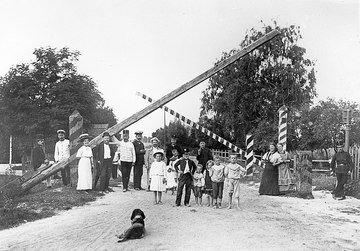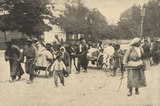The Austrian Ruthenians played a certain ground-breaking role in the formation of a Ukrainian national consciousness, because under the rule of the Tsars the existence of an autonomous Ukrainian nation was discussed, if at all, only by their co-nationals.
The development of national consciousness among the Ruthenians respectively Ukrainians was hampered by the border drawn between Austria and Russia, which cut the Ukrainian linguistic zone into two. In Russia, where the Ukrainians were called in contemporary diction “Little Russians”, Ukraine was seen as a dwarf within the Pan-Russian nation. In contrast, the Habsburg Empire supported the idea of an autonomous Ukrainian nation, when, in the nineteenth century, the first national sentiments were aroused among the Ruthenians, as this ethnic group was officially designated in Habsburg Austria. It was not so much selfless human sympathy that was behind Vienna’s positive reaction to the shy attempts towards emancipation, but the calculation of hobbling any Pan-Slavic trends towards unification.
Yet within the Habsburg Monarchy as well the Ruthenians found themselves split between the Austrian and the Hungarian halves of the empire, both of which offered very different possibilities of development. The Carpathian Ukrainians, who, naming themselves Rusyns, saw themselves as an autonomous ethnic group, demanded autonomy within Hungary – an aspiration devoid of any success in the face of the keen Magyarisation policies of the Hungarian government.
The development in Galicia and Bukovina was somewhat more favourable, where, however, the Ruthenians were likewise disadvantaged. In Galicia the Polish élites attained a de-facto autonomy in the second half of the nineteenth century, which resulted in a Polonisation of school education and the administration. The Ruthenians, mainly belonged to the economically weak classes and because of the census franchise were for a long time glaringly underrepresented in political affairs.
In view of the triste situation in the ancestral areas, the organisations of the Ukrainian diaspora abroad played a significant role. Political awareness among Ruthenians was promoted to major degree by emigrant associations mainly living in the USA
In the early twentieth century the Ruthenian national movement in the Habsburg Monarchy was split because of the inner-Ukrainian controversy about ethnic identity. The national-Ukrainian wing stressed the autonomy of the Ruthenian nation and committed itself to a national movement within the Austrian context. However, this increasingly lost influence in the face of growing pro-Russian, Orthodox-clerical orientation. Faraway Vienna sensed the danger of Pan-Slavism in the air – an attitude that was exacerbated with the outbreak of the First World War, when the Ruthenians were seen as a fifth column of the Russians and branded across the board as unreliable. Alone the declaration of national standpoints and a nationally conscious demeanour were seen as suspicious and were persecuted. The civilian population was particularly oppressed. When the Ruthenian settlement regions became theatres of war, mass de-settlement strategies were practised, since the Imperial-Royal military administration feared a collaboration of the settled population with the enemy Russian troops.
Translation: Abigail Prohaska
Rumpler, Helmut: Eine Chance für Mitteleuropa. Bürgerliche Emanzipation und Staatsverfall in der Habsburgermonarchie [Österreichische Geschichte 1804–1914, hrsg. von Herwig Wolfram], Wien 2005
Bihl, Wolfdieter: Die Ruthenen, in: Wandruszka, Adam/Urbanitsch, Peter (Hrsg.): Die Habsburgermonarchie 1848–1918, Band III: Die Völker des Reiches, Wien 1980, Teilband 1, 555–584
-
Chapters
- Poles and Ruthenians in the Habsburg Monarchy
- At the Margins of the Empire: Galicia and Bukovina
- The struggle of the Poles for their nation: Poland is not yet lost!
- Compromise with Vienna: Polish Autonomy in Galicia
- The Poles in the First World War: a Nation as Football for the Great Powers
- The Great Unknown: The Ruthenians
- Approach and Rejection: The Ruthenians between Austria and Russia





